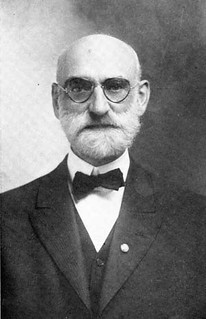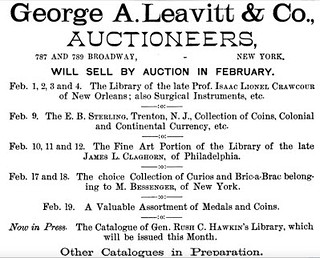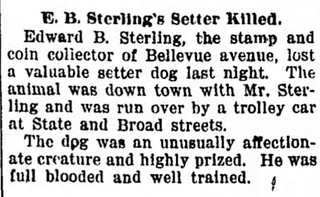
PREV ARTICLE
NEXT ARTICLE
FULL ISSUE
PREV FULL ISSUE
EDWARD BOKER STERLING (1851-1925)
John Lupia submitted the following information from his Encyclopedic Dictionary of Numismatic Biographies for this week's installment of his series. Thanks! As always, this is an excerpt with the full article and bibliography available online. This week's subject is
Dr. Edward Boker Sterling of New Jersey.
-Editor
At age thirteen he was obliged to quit school and earn a living. He first worked as a clerk in a dry goods store. Afterwards he worked for the Lehigh Valley Railroad. Later he worked for Samuel B. Packer (1831-1904), in the coal business as a bookkeeper for his coal shippers of New York. After work he attended the evening classes at a commercial college. In 1879 he became a bank clerk at the Trenton Banking Company (1804-1929). Edward Boker Sterling was a mycologist, i.e., a mushroom expert as well as a very popular stamp and coin dealer who became more well-known among the philatelists due to his short-lived business connection with Hiram Edmund Deats when they purchased 213 tons of printed engraved paper materiel from the United States Treasury Department that was earmarked as worthless. The details of that fascinating story were reported by Sterling in an article "Sterling's Speculations," hilatelic Journal of America, Vol. VI, No. 70, October (1890) : 254. Wagon load after wagon load of revenue stamp stub books from the 4th floor of the United States Treasury Department were hauled into the basement of the Board of Trade building, East State Street, Trenton, New Jersey by Sterling and at least eight boys after Deats and Sterling bought them. In 1877, he published, Descriptive Price Catalogue of the Stamps of the United States, attempted by E.B. Sterling (Trenton, New Jersey)
Sterling was a correspondent with the Chapman Brothers stamp and coin dealers at Philadelphia, Pennsylvania. Sterling owned thirty-four varieties of U. S. Silver Dollars from 1794 to 1803, which were sold together with many other coins and paper money in February 1887 by Ed Frossard. In 1886, he was among the founding members of the American Philatelic Association. On February 9, 1887, Ed Frossard's coin auction catalogue of the Edward B. Sterling Collection was sold at Leavitt's Auction Rooms, New York. This was the first in a series of seven auctions Frossard catalogued for Edward B. Sterling the last selling at auction on September 27, 1888. This advertisement published in The Bookmart, Vol. 4, February (1887) : 379 On January 18, 1887, he became a member of the ANS.
In 1907 Philatelic West he advertised to buy all New Jersey State bank notes, willing to trade various items including stamps, autographs, engravings, books, old newspapers, foils etc. On November 29, 1925, after a protracted long suffering he passed away at his home at 941 Edgewood Avenue, Trenton, New Jersey. He was buried at the Ewing Church Cemetery. In 1997 Sterling was placed in rolls of the American Philatelic Society Hall of Fame.
While Sterling was more active in philatelics, he was clearly also a collector of and dealer in coins. As noted in last week's articles (linked below), the stamp and coin worlds were quite intertwined in those early days. Be sure to see the complete article online for more information, including Sterling's notable discovery of the largest mushroom in the world. -Editor
To read the complete article, see:
To read the earlier E-Sylum articles, see:

Wayne Homren, Editor The Numismatic Bibliomania Society is a non-profit organization promoting numismatic literature. See our web site at coinbooks.org. To submit items for publication in The E-Sylum, write to the Editor at this address: whomren@gmail.com To subscribe go to: https://my.binhost.com/lists/listinfo/esylum All Rights Reserved. NBS Home Page Contact the NBS webmaster 
|


